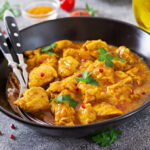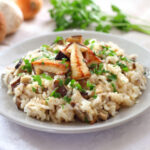I came upon a Pampered Chef glazed on the outside, and unglazed on the inside stoneware oven roaster while organizing my kitchen. I remember this purchase so well, assuring myself that I would use this roaster often. I examined it on rediscovery–not a sign of use, pristine. I reviewed the literature that had informed my choice, words that promised moist, succulent, tender meats and poultry, and great versatility. I decided to challenge myself to use the roaster to create some dishes and to decide whether to keep them or free up some storage space. I will save you the suspense and tell you now that I will be using this roaster frequently throughout Autumn and Winter. I would go so far as to suggest that, if you do not own one, you may consider shopping for one–there are a variety of brands on the market.
I began with one of my favorite dishes to prepare, Roast Chicken. This technique is so simple, so hands-off, and it yields a chicken that is moist, falling off-the-bone tender, and infused with wine-lemon-herb flavor. I uncovered it and raised the heat a bit for the last 15 minutes of roasting and browned the bird, so it had a lovely golden-brown color.
Emboldened, I decided to create a simple Boeuf Bourguignon, that rather fussy, a multitude of steps French beef-red wine stew. The outcome was spectacular. The beef was tender, the vegetables perfectly cooked, and the sauce rich with red wine, stock, caramelized onions, and mushrooms.
I decided that this roaster and the slow braising technique would likely create a luscious Turkey Pot Pie, another comforting Fall or winter one-pot meal. So, I was off to the market to pick up some turkey tenderloin and leeks, fresh sage, and a good dry Riesling wine. I think that the possibilities for this little stoneware roaster may be infinite.
Contents
Slow Oven Braised Whole Chicken with White Wine and Herbs
Serves 4
Total roasting time 3 and 1/2 hours)
Ingredients
- 1 – 3 and 1/2 pound roasting chicken, lean and patted dry
- Olive or canola oil to brush the chicken
- fine Kosher salt, pepper
- 2 Tablespoons dried thyme (or Tarragon is very good)
- 2 lemons, quartered
- 1 large sweet onion, cut into eighths
- 3 fat cloves of garlic, smashed
- 2 cups dry white wine
- 1 cup chicken broth
Method
If your stoneware is new, then brush the interior of the base and lid with vegetable oil.
Season the cavity of the chicken with salt and thyme. Brush the chicken with oil, and season the exterior with salt, pepper, and thyme.
Place the chicken in the base of the roaster and place the onion, lemon, and garlic around the chicken.
Pour the wine and broth into the base.
Cover the chicken with the roaster lid.
Place the roaster in the cold oven, and turn the oven to 325 degrees F. (note: these stoneware roasters are sensitive to dramatic changes in temperature, so place it in a cold oven and then set the temperature.)
Roast for 3 hours, and then uncover for the last /12 hours and turn the oven temperature to 375 degrees to brown the chicken.
Remove the chicken to a platter, cover it, and allow it to rest for 10 minutes. Carve and spoon the white wine, and broth juices over the chicken.
This is the simplest, most hands-off method for roasting a chicken, and the moistness, tenderness, and flavor are excellent. While my chicken roasted, I relaxed and read a book, and savored the aromas wafting from the kitchen! And, this is a technique, so you can tinker with the wine, herbs, and flavoring agents to suit your taste. Tarragon for the herb, champagne for the wine, and orange for the citrus? You decide!
Easy Boeuf Bourguignon
I have made very traditional Boeuf Bourguignon, following either Julia Child’s or Jacques Pepin’s recipe. While the traditional French beef stew in red wine is decadent, rich, and very delicious, we do not always have the time to take the multitude of steps that traditional recipes require. So, here is a simple version that resulted in a hearty, rich, earthy beef stew.
Serves 4
Ingredients
- 1 large sweet onion diced
- 1 Tablespoon olive oil
- 1.25 pounds beef stew meat in 1 and 1/2-inch cubes
- 4 carrots, scrubbed and diced small
- 2 large parsnips, scrubbed and diced small
- 8 ounces of baby portabella mushrooms, quartered
- 1 cup fresh garden peas
- fine kosher salt
- pepper
- 2 Tablespoons dried thyme
- 3 bay leaves
- 3 cloves smashed garlic
- 2 cups full-bodied red wine (a Burgundy would be traditional–I used a good Italian Pinot Noir)
- 1 cup beef stock with 2 teaspoons cornstarch or potato starch whisked in til smooth (a slurry for thickening)
Traditionally, Boeuf Bourguignon begins by rendering the fat of salt pork or bacon. I elected not to do this, just as I elected not to enrich the sauce with butter. However, you can use bacon or pancetta, or salt pork diced to render fat to caramelize the onions in if you wish. I caramelized the diced onion in olive oil. This takes about 15 minutes on medium-low heat.
Add the wine to the skillet and deglaze the pan. Add the broth, and turn off the heat.
Season the meat and diced vegetables with salt, pepper, and thyme. Place the meat and all vegetables into the roaster base, and pour the onion-wine-both mixture over it. Place the lid on the roaster and place in a cold oven. Turn the oven to 325 degrees F.
Roast undisturbed for 2 hours. Make a slurry of 1 cup broth and 2 teaspoons of cornstarch or potato starch, whisking to dissolve. Remove the roaster from the oven, uncover it, and stir in the slurry, which will thicken the sauce. Return the stew to the oven without the cover for 1/2 hour.
Remove the roaster from the oven, and prior to serving, stir in a 1/2 cup additional red wine. Garnish with freshly chopped thyme leaves or parsley, if you wish. I served this hearty beef stew over smashed, baked russet potatoes, lightly buttered and then flavored with a few drops of white truffle oil. Another very simple, but rich and delicious dinner that allowed me time out of the kitchen for gardening, reading, and looking for my next inspiration.
For my next easy, oven-braised dish, I am going to go for Thanksgiving preview Fall flavors–chunks of turkey breast, leeks, mushrooms, butternut squash, sage, turkey stock, and Riesling wine; and, if I can coax Pastry Chef Michael Ostrander to give me some tips on making a flaky, savory pastry, I just might top this turkey casserole with a bit of pastry,
- 1 – 3 and 1/2 pound roasting chicken, lean and patted dry
- Olive or canola oil to brush the chicken
- fine Kosher salt, pepper
- 2 Tablespoons dried thyme (or Tarragon is very good)
- 2 lemons, quartered
- 1 large sweet onion, cut into eighths
- 3 fat cloves of garlic, smashed
- 2 cups dry white wine
- 1 cup chicken broth
- If your stoneware is new, then brush the interior of the base and lid with vegetable oil.
- Season the cavity of the chicken with salt and thyme. Brush the chicken with oil, and season the exterior with salt, pepper and thyme.
- Place the chicken in the base of the roaster and place the onion, lemon and garlic around the chicken.
- Pour the wine and broth into the base.
- Cover the chicken with the roaster lid.
- Place the roaster in the cold oven, and turn the oven to 325 degrees F. (note: these stoneware roasters are sensitive to dramatic changes in temperature, so place it in a cold oven and then set the temperature.)
- Roast for 3 hours, and then uncover for the last /12 hour and turn the oven temperature to 375 degrees to brown the chicken.
- Remove the chicken to a platter, cover, and allow to rest for 10 minutes. Carve and spoon the white-wine, broth juices over the chicken.
I would love to hear about your creations using your slow oven roasting tools and techniques, so please use the comment box below to share! Perhaps you have a favorite technique that you find allows you a lot of versatility–share it here!






